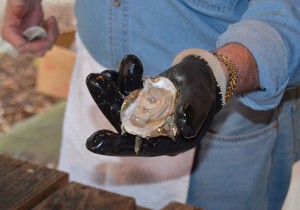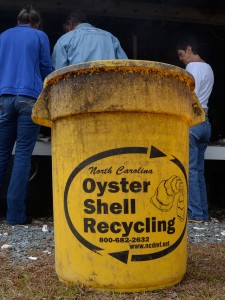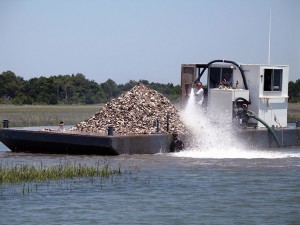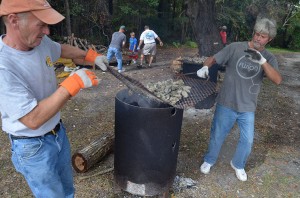By JACK HORAN
Every first Saturday in November, hundreds of people gather in the Brunswick County Town of Varnamtown for an afternoon of shuckin’ and socializin’.
They shuck bushel after bushel of freshly fired oysters at the annual Dixon Chapel United Methodist Church Oyster Roast. For 60 years, the church has been sating appetites of oyster lovers from the coast, the Piedmont and well beyond, through this $20, all-you-can-eat fundraiser.
It’s the oldest of 12 publicly promoted North Carolina oyster roasts. Church and community members shovel freshly caught bivalves onto heavy-duty grills. Then, pairs of volunteers hoist each batch onto an oak-burning cooker the size of a backyard trash can. Orange flames lick upward, sending flakes of ash drifting through the air.
How long does it take to roast an oyster? Five to 10 minutes, says Jesse Butterbaugh of nearby Supply, watching over a cooker. “Just until they start opening up. See how that’s opening up and the juice is running out? They get like that.” Suddenly an oyster pops and hisses and spits hot juice. “That’ll let you know when they’re done.”
The oysters soon begin to sizzle. Volunteers grab the grills, stride 30 feet over to a picnic shelter with long wooden tables behind the church, and dump the sputtering, hot oysters in front of delighted patrons. Clouds of steam billow up from the mounds.
Veteran oyster-shuckers bring more than just an oyster knife to pry open the shells.

Oyster fanciers downed 158 bushels of Lockwood Folly Rover oysters at the 60th annual Dixon Chapel United Methodist Church Oyster Roast. Photo by Jack Horan.
They wear a single leather glove to handle the hot shells. And they tuck a hand towel into their belts to wipe grimy oyster-shell soot from their fingers.
Standing shoulder to shoulder, shuckers open the mollusks with the thick-bladed knives, sometimes sprinkling hot sauce or lime juice on the light-gray meat, alternately swallow a mouthful of sweet pickles and hush puppies, and wash it all down with soft drinks or coffee.
Diane Phillips came to the event, her first, last November at the urging of co-worker John Dawson, a roast volunteer for about 40 years. “I’m going to have to say these are some of the best oysters that I think I’ve ever had. And I grew up eating oysters,” says Phillips, a Wilmington native. “I have not had an oyster yet — and I’ve been here, what, about an hour eating as fast as I can — that I couldn’t open, that wasn’t pristinely clean and salty and juicy. I’m a happy girl and this is a great fundraiser.”
Some 800 community members and visitors devoured 158 bushels of oysters, as well as 200 pounds of spot and flounder for fish plates.
Among them was Ron Farmer of Charlotte. It was his 28th straight roast. Farmer learned of the event through a friend, Lee Edwards of Charlotte, whose father grew up in the area.
“The people are so friendly,” Farmer says. “They just make you feel so welcome. If it was $50 apiece, I would get my money’s worth. It’s unusual, simple fun. The common denominator is oysters.” Farmer brought along his brother Adam Farmer of Guilford County.
RETURNED TO WATER
As oyster meat slides into stomachs, oyster shells go another route. Diners drop them into yellow buckets supplied by the N.C. Division of Marine Fisheries, or DMF, for recycling.
Starting with a 2003 pilot program, DMF has promoted the recycling of oyster shells. The agency has been collecting and deploying shells to create new oyster reefs in rivers and sounds. Returning shells to the water provides a foundation for oyster larvae to settle and grow, helps rebuild oyster populations and enhances habitat for fisheries. It also reduces solid waste in landfills. Since 2007, state law has made it illegal for anyone to knowingly dispose of oyster shells in landfills.
The 2013 DMF stock status report categorizes oysters as a species of “concern” because of the “long-term decline caused by excessive harvest and habitat disturbances,” as well as pollution and disease.
Recycled shells are valuable for rebuilding the state’s oyster population because young oysters are drawn to oyster shells, explains Sara Mirabilio, North Carolina Sea Grant fisheries specialist.

At the roast, discarded shells are recycled to create new oyster reefs in North Carolina waters. Photo Jack Horan.
“The main thing is that the research that Sea Grant has funded shows that free-floating larvae like to settle on oyster shells first and foremost,” she notes. “They will settle on other substrate. But given a preference, they will settle on shells.”
Researchers think chemical cues are a major factor, Mirabilio adds, and thus the recycled shells give larvae the home they’re looking for. “That’s the main reason they’ve been putting shells out there,” she continues.
These shells provide protection for the spat, and also become substrate where the spat can attach themselves and grow into adult oysters.
The recycling program has expanded significantly over 10 years. As of 2013, DMF had established more than 100 drop-off collection sites at landfills and restaurants in 24 mostly eastern counties. The sites were found as far west as Durham, Orange and Wake counties and Cabarrus County, next to Charlotte. In 2006, the N.C. General Assembly began giving a tax credit of $1 per bushel of oyster shells donated as an incentive to recycle. That credit, however, expired Dec. 31, 2013.
As of early 2013, the most recent figure available, the program has yielded 185,885 bushels of shells, the most current figure available. That has created about 38 acres of new oyster beds, DMF spokeswoman Patricia Smith notes.
Recycling oyster shells helps the state enhance oyster beds, which helps promote oyster populations and, in turn, improves water quality of rivers and sounds. A Sea Grant research project, reported in the Autumn 2012 issue of Coastwatch, concluded the nitrogen-recycling value of an acre of oyster reef is estimated to be $3,000 a year compared to $400 for an acre of mudflat without oysters.
But oyster shell recycling, for all its successes, has been sharply curtailed. The program took a big hit in 2013 when the legislature cut DMF’s budget by $514,788 for fiscal year 2013–2014.
Smith explains the cutback forced the agency to drop the Oyster Shell Recycling Program, with its annual cost of $54,131. The program’s coordinator was transferred to another position.
“While it was a difficult decision,” Smith notes, “the division chose to eliminate the Oyster Shell Recycling Program as part of the required reduction because it is not a statutorily required program.” She adds that, “The division does want to continue to recycle oyster shells and would like to partner with nongovernment organizations and/or volunteers in this effort.”
With this change, Smith anticipates that collections of shells could drop by 50 percent or more. “The division intends to continue bulk collections from high-volume producers that have areas to store the shells, and from landfills.”
Money from the Coastal Recreational Fishing License Grant Program, or CRFL, is now picking up the costs for bulk collections.
The division got $60,000 in two grants for the 24 months ending June 30, 2014, that it uses for bulk collections. Then, in December, it received a $15,000 grant that will enable the division to continue those collections through June 2015.

The oyster shells are blown into the water, often at sites where reefs have thrived in the past. Photo courtesy N.C. Division of Marine Fisheries.
“The Division of Marine Fisheries will continue to collect oyster shell from waste collection/landfill sites, including the landfills in Orange and Wake counties, as well as other sites where large amounts of shell are collected, such as Morris Landing in Holly Ridge, the Bridge Barrier Road site near Carolina Beach and the trailers in front of the division headquarters in Morehead City,” Smith says.
The public can take oyster shells to these sites. But DMF no longer will collect low-volume shells from restaurants, oyster roasts and convenience sites, which used the yellow trash cans instead of large bins.
She says DMF will look for potential cost-effective sources of discarded shells from, for example, oyster-shucking houses, and will seek approval from regulatory agencies to use alternative reef-building materials such as crushed, recycled concrete.
Meanwhile, in early 2013 the division produced a 10-minute video on DVD extolling the benefits of recycling shells, through a fourth CRFL grant that was approved in 2010.
The $35,000 grant bought 3,250 DVDs, entitled Oyster Shell Recycling for Healthy Waters, and 50,000 recycling information cards. The DVDs will be distributed to civic and conservation groups, and schools.
Sea Grant is one of five partners that helped produce the video, which includes scenes taken at a previous Varnamtown oyster roast.
‘A SHUCKIN’ GOOD TIME’
The Dixon Chapel roast started in 1953, according to Marlene Varnam, one of the event’s organizers. “The church decided to have a Thanksgiving oyster roast,” she says. “Other people found out about it and started coming.
People (here) still eat oysters for Thanksgiving.” Her friend, Beatrice Varnam, 89, remembers working that first roast. They charged $5 a head. “The first one we had we made $98. We thought we had done good. Everyone enjoyed the eating and the cornbread especially.” In 2013, attendees paid four times that, and the church expected to net about $10,000.
Marlene Varnam says the roast has never been called off because of rain. And the event has never lacked for oysters, traditionally harvesting them from the Lockwood Folly River, next to Varnamtown.
The 2007 roast, however, was a close call. Eight days before that roast, state shellfish sanitation inspectors temporarily closed Lockwood Folly after a heavy rain washed bacteria-laced runoff into the river. The inspectors reopened the river two days before the roast, after bacteria counts fell to safe levels, giving oystermen enough time to gather the shellfish, according to the Wilmington Star-News.

Agusta Varnam and Terrence Galloway guard against scalding juice as they grab a grill of oysters during the roast. Photo by Jack Horan.
For the 2013 roast, all 175 bushels of oysters came from Lockwood Folly. The church paid $30 a bushel, according to Marlene Varnam. The mollusks were washed and stored at 43 degrees F at Carson Varnam’s Shellfish Market across the road from the church. The market bears the name of Marlene Varnam’s late husband, an oysterman. To ensure freshness, her grandson, Mikey Fulford, loaded the oysters into a refrigerated truck and drove them 500 feet to the church.
The church advertises the roast as “A Shuckin’ Good Time.” Oyster fanciers, taking a break from shucking and shelling in the overflowing shelter, give a thumbs up.
Mary Pyland of Burgaw has been a regular for seven or eight years. She comes while visiting friends. “It’s a great thing to meet people from different areas and have good food and good fellowship, all in the same place,” she says.
A Monroe nursing-home resident, Ray Carnes, 81, got his annual shellfish treat, thanks to family members who accompanied him the 180 miles from Union County to Varnamtown.
“We try to come every year,” says his wife, Nora, 69, of Indian Trail in Union County.
The Carneses have attended the event since the mid-1980s.
For Johnny Ezzell of Supply, the 60th roast was his first but, he predicts, not his last. He sums up the experience this way: “Good fellowship, good food. Reasonable price. Good price. All you can eat. It’ll be an annual thing for me.”
To learn more about the Oyster Shell Recycling Program and find shell-recycling sites, go to portal.ncdenr.org/web/mf/home and search for “oyster shell recycling.” Contact North Carolina Sea Grant or the N.C. Division of Marine Fisheries for a copy of the Oyster Shell Recycling for Healthy Waters DVD.
This article was published in the Winter 2014 issue of Coastwatch.
For contact information and reprint requests, visit ncseagrant.ncsu.edu/coastwatch/contact/.
